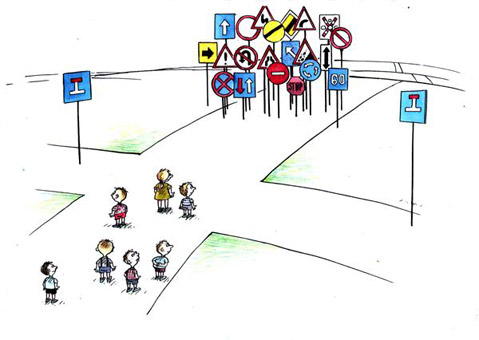Dyslexia: A Difference, Not a Disability
To/Two/Too Read/Reed/Rede and Write/Right/Rite

If only I had known then what I know now.
That’s what so many parents say when they finally learn that their little kid’s cute mispronunciation of words meant something about how he or she would read: hanguber, heckicopater, psiketti. It meant something about how his or her brain was wired, a difference that becomes pronounced in school, but not necessarily in life.
As bigger kids, dyslexic children may have difficulty spelling their names, reciting the alphabet, or remembering the days of the week and the months of the year. And it becomes time for serious intervention when they can’t sound out words or, for the life of them, remember the multiplication tables or spell with any understanding at all. They can tell a story with vivid detail, but they can write only a few sentences, and then with great difficulty.
Ask anyone on the street “what is dyslexia?” and you’ll likely get a baffled expression, a shrug, or speculation that it’s something that causes people to see things backward. That’s what filmmaker Harvey Hubbell V did in his new independent film, Dislecksia: The Movie, an entertaining and informative look at a different way of learning shared by 1 in 5 individuals, including the filmmaker himself.
And my own son. Looking back, he exhibited classic signs of dyslexia long before he entered kindergarten.
Thay probbblee hav a leerning difrenz. Thay likely hav disyleckseeeya.
The written word can be a source of never-ending misery for individuals who have dyslexia, a hereditary, neurobiological brain difference — in the simplest of terms — in which the right brain ends up doing the work the left brain is supposed to do. For them, the sounds that letters make are not well understood or easily decoded, making reading more a guessing game than an ever-evolving skill. For them, without specialized teaching methods, books don’t reveal stories; they hide them deep within.
Thay spend theyre tyme lerningg two reeed wen uthers r reiding too lern.
What happens to a student who falls behind the rest of the class, who just doesn’t learn how to read, write, and spell like the other students? Never mind that these kids may be smart, motivated, and working as hard as they can to crack the code and become fluent readers, elegant writers, and competent spellers. It doesn’t happen. Year after year after year. Far too many may veer off-path and into trouble.
Eye cann’t due thiss butte eye can due thattt.
At the same time, though, these kids may reveal talents in understanding math concepts and creative problem-solving, or uncanny abilities in sports, the arts, or on-the-ground navigating from one point to the next. If they stay on-path, they can be very successful once they’re out of school, where reading, writing, and standardized testing aren’t everyday requirements.
More than one-third of all adult entrepreneurs have dyslexia — and practically all the astrophysicists working on black holes have dyslexia, too. And inventors from Leonardo da Vinci to Thomas Edison to Albert Einstein.
The beauty of this brain difference is that the weakness with the written word is balanced, maybe even overshadowed, by strengths in other areas. That dyslexia is a difference, not a disability, is the message that current-day researchers and experts have finally realized, providing countless new resources that change the discussion from stressful to successful. Even Malcolm Gladwell addresses the subject in his new book, David and Goliath.
Parents, it’s time to develop a new parenting skill: Learn how to interpret those early signs that reveal how our kids learn, and help them achieve their full potential by recognizing their strengths and accommodating their weaknesses — including those who have dyslexia.
The Santa Barbara High School PTSA hosts a panel discussion on “Dyslexia and Learning Differences” at the high school cafeteria on Wednesday, November 20, at 6:30 p.m. The author, Christine Feldman, SBHS special education director Tiffany Carson, and the district’s Special Education director of secondary education Kirsten Escobedo will participate.
Cheri Rae directs The Dyslexia Project and recently worked with the Santa Barbara Unified School District to establish the Parent Resource Center at the district office, 720 Santa Barbara Street. She is currently working on her newest book project, DyslexiaLand: A Guide for Parents, Educators and Students.



